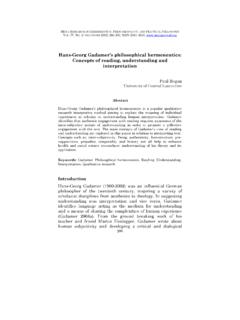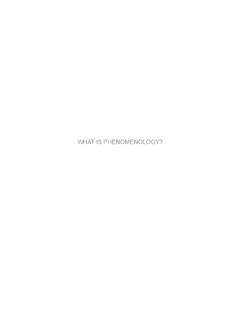Transcription of INEQUALITIES AND EQUATIONS: HISTORY AND DIDACTICS
1 In Bosch, M. (Ed.). Proceedings of CERME 4. Sant Feliu de Gu xols 2005, 652 662. INEQUALITIES AND equations : HISTORY AND DIDACTICS . Giorgio T. Bagni Department of Mathematics and Computer Science, University of Udine (Italy). Abstract. The historical development of equations and INEQUALITIES is examined, in order to underline their very different roles in various socio-cultural contexts. From the educational point of view, historical differences must be adequately taken into account: as a matter of fact, a forced analogy between equations and INEQUALITIES , in procedural sense, would cause some dangerous phenomena. 1. Introduction: algebraic equations and INEQUALITIES Frequently, from the educational point of view, algebraic INEQUALITIES are introduced to pupils after algebraic equations , and the solving techniques are strictly compared.
2 Nevertheless, in classroom practice, techniques for equation solving, when applied to INEQUALITIES , lead sometimes to wrong results: so didactic connections between equations and INEQUALITIES are not simple to be stated (a number of papers can be found; for instance: Linchevski & Sfard, 1991 and 1992; Fischbein & Barash, 1993;. Tsamir, Tirosh & Almog, 1998). Some experimental studies by L. Bazzini and P. Tsamir (2002) clearly pointed out several meaningful situations. Let us note that the word equation, in English, denotes the mathematical statement of an equality. For instance, by writing x+2 = 5 (equation) we state that the x+2 is equal to 5: and this is true if and only if x = 3 (solution of the considered equation).
3 Of course we can consider an equality also without a proper equation, without an unknown: when we write, for instance, 2+7 = 9 we state that the sum of the numbers 2 and 7 is equal to 9 (frequently a statement of an equality that is true for all values of a variable, 2x+7x = 9x , is indicated by the word identity) and this is true. From the logical point of view, 2+7 = 9 is a sentence that expresses a proposition with the truth value true ; x+2 = 5 is not a sentence: it does not express a proposition, but a condition regarding the values which may be assigned to the variable involved (Bell & Machover, 1977, p. 12) and it will assume a truth value, either true or false , depending on which number is assigned to x as a value.
4 Let us now consider the inequality x+2 < 5 : by that we state that x+2 is less than 5. and this is true if and only if x < 3. In several languages the word inequality can assume two different versions, so it is translated by two different words: for instance, in French, these words are in galit (in Italian: disuguaglianza) and in quation (disequazione).1 With reference to these words, the mentioned difference would be summarised as follows: an in quation is the mathematical statement of an in galit . Both from a logical point of view and from an educational point of view, there is a great difference between an inequality like x+2 < 3 and an inequality like 1+2 < 5: their epistemological status is clearly different.
5 1. Sometimes, in English, an inequation denotes a statement that two quantities or expressions are not the same, or do not represent the same value (written by a crossed-out equal sign: x y). We shall denote the first inequality by the term in quation, the second by in galit . 2. HISTORY and DIDACTICS : different theoretical perspectives Our work will take into account some references from the HISTORY of Algebra. As several studies have pointed out, the historical approach can play a valuable role in mathematics teaching and learning and it is a major issue of the research in mathematics education, with reference to all school levels (Heiede, 1996).
6 The use of the HISTORY into education links psychological learning processes with historical-epistemological issues (Radford, Boero & Vasco, 2000, p. 162) and this link is ensured by epistemology (Moreno & Waldegg, 1993). Concerning the features of interactions between HISTORY and educational practice, a wide range of views can be examined. Different levels can be considered with reference to teaching-learning processes: a first is related to anecdotes presentation (and it can be useful in order to strengthen pupils' conviction: Radford, 1997); higher levels bring out metacognitive and multidisciplinary possibilities. Let us consider the following representation: (where some well known terms by Y.)
7 Chevallard are employed). Of course this is just a schematic outline: for instance, the passage from the savoir savant to the savoir enseign is not simple. However two sets of connections must be analysed: connections (1) between mathematical contents and historical references;. connections (2) between mathematical contents linked to historical references and knowledge presented to pupils in classroom (after the transposition didactique). Different uses of the HISTORY into DIDACTICS do not reflect just practical educational issues: they imply different epistemological assumptions (Radford, 1997 and 2003). For instance, the selection of historical data to be presented in classroom practice is epistemologically relevant: this selection reflects some epistemological choices by the teacher, too.
8 Important problems are related to the interpretation of historical data: this is frequently based upon our cultural institutions and beliefs (Gadamer, 1975). Frequently the role of the HISTORY into DIDACTICS is considered from an introductory point of view2: sometimes a parallelism between the historical development and the 2. Teachers can be induced to apply historical knowledge to classroom practice according to a na ve approach (as noted in Radford, 1997): for instance the educational introduction of a topic would take place just by the ordered presentation of all the historical references related with it. cognitive growth is assumed (since E.)
9 Haeckel's law of recapitulation , 1874; see: Piaget & Garcia, 1989). As a matter of fact, a new concept is often encountered by mathematicians in operative stages, for instance in problem solving activities, and it will be theoretically framed many years or several centuries later (Furinghetti &. Radford, 2002); a parallel evolution can be pointed out in the educational field: often the first contact with a new notion takes place in operative stages (Sfard, 1991; see the discussion in: Radford, 1997): in fact, pupils' reactions are sometimes rather similar to reactions noted in mathematicians in HISTORY (Tall & Vinner, 1981) and such correspondence would be an important tool for mathematics teachers.
10 The mentioned parallelism would require a theoretical framework: as a matter of fact, it leads to epistemological issues. A major issue is related to the interpretation of HISTORY : for instance, is it correct to present the HISTORY as a path that, by unavoidable mistakes, obstacles overcoming and critical reprises, finally leads to our modern theories? What is the role played by social and cultural factors that influenced historical periods? Mathematical contents deal with non-mathematical context, too, and knowledge must be understood in terms of cultural institutions (Bagni, 2004). According to the epistemological obstacles perspective by G.








